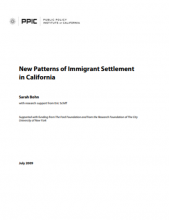New Patterns of Immigrant Settlement in California
This report discusses California's "decline in popularity" among immigrants, as evidenced by its falling share of the nation's immigrant population. Although still the state with the highest number of immigrants, its percentage of the nation's immigrant population dropped from its historic high of 32.7% in the eighties to 26.4% in 2007. A process of immigrant dispersal has taken place within the nation and within California itself, as counties within the state that previously had not seen large immigrant populations, such as Alameda and Sacramento, show much higher growth than traditional gateway communities like Los Angeles and San Francisco. During the same period, the educational level of new immigrants to California has risen, with declines in the number of immigrants without high school diplomas and increases in the number of college graduates. The report also comes to a "striking conclusion," i.e. that there has been a "decline in social factors as a driver of location choice" among immigrants. The magnet of a pre-existing immigrant community may be less strong today in attracting new immigrants than the availability of good jobs at above average wages. Finally, the report notes a reversal of the trend of native-born Americans leaving areas of high immigrant concentration. Instead, both native-born and immigrants seem to be moving to the same destinations.
Bohn, S. (2009). New Patterns of Immigrant Settlement in California. Public Policy Institute of California. Retrieved from https://www.ppic.org/content/pubs/report/R_709SBR.pdf

